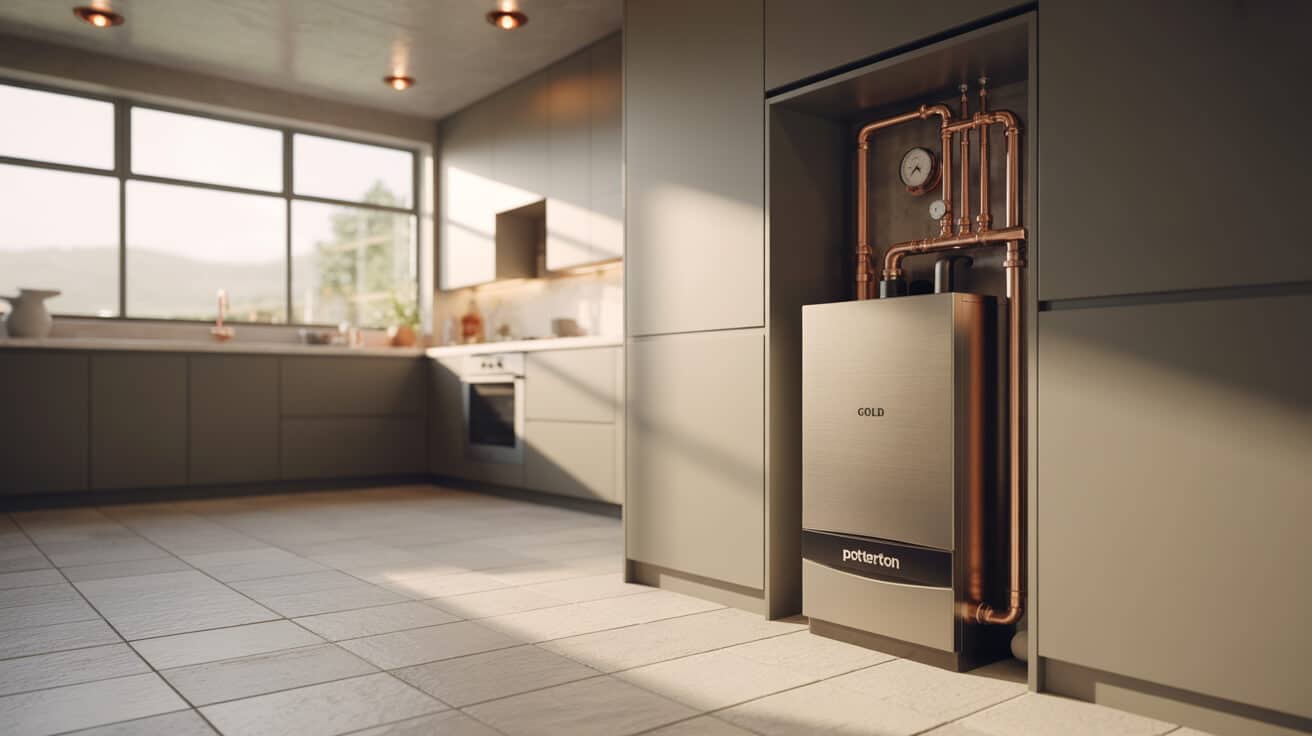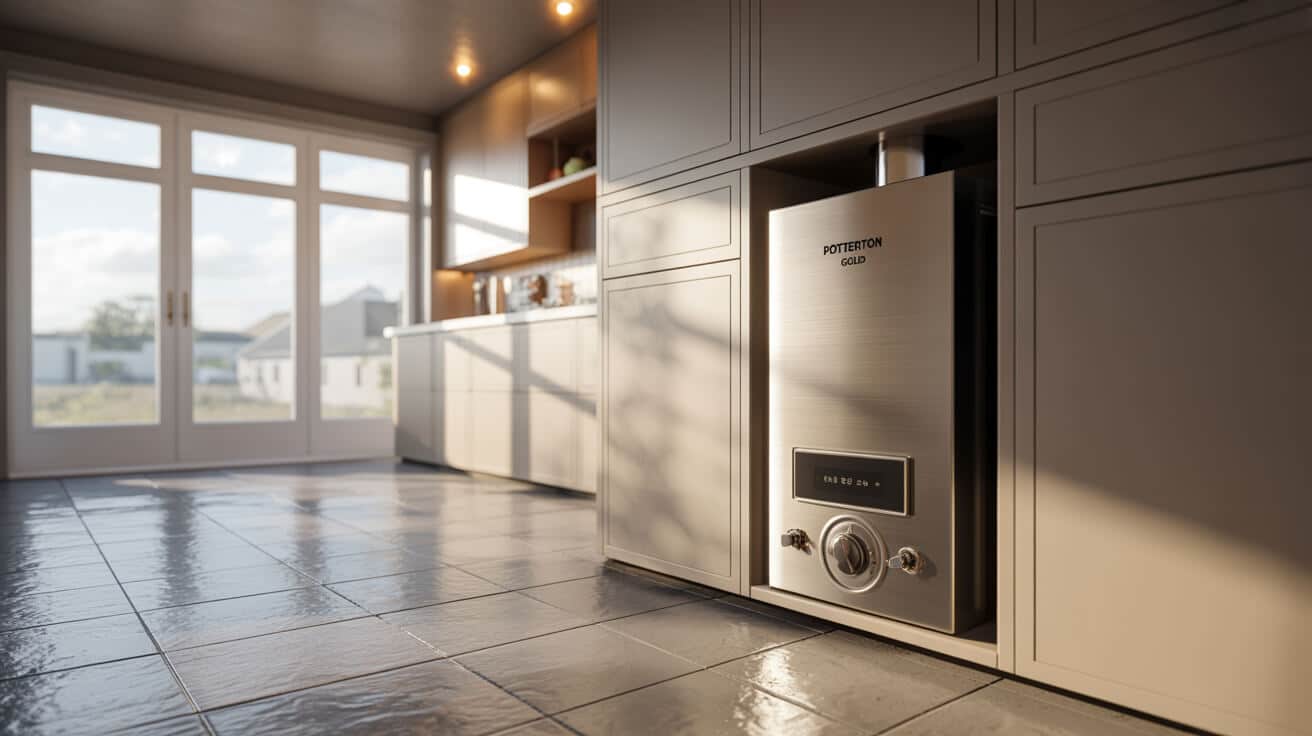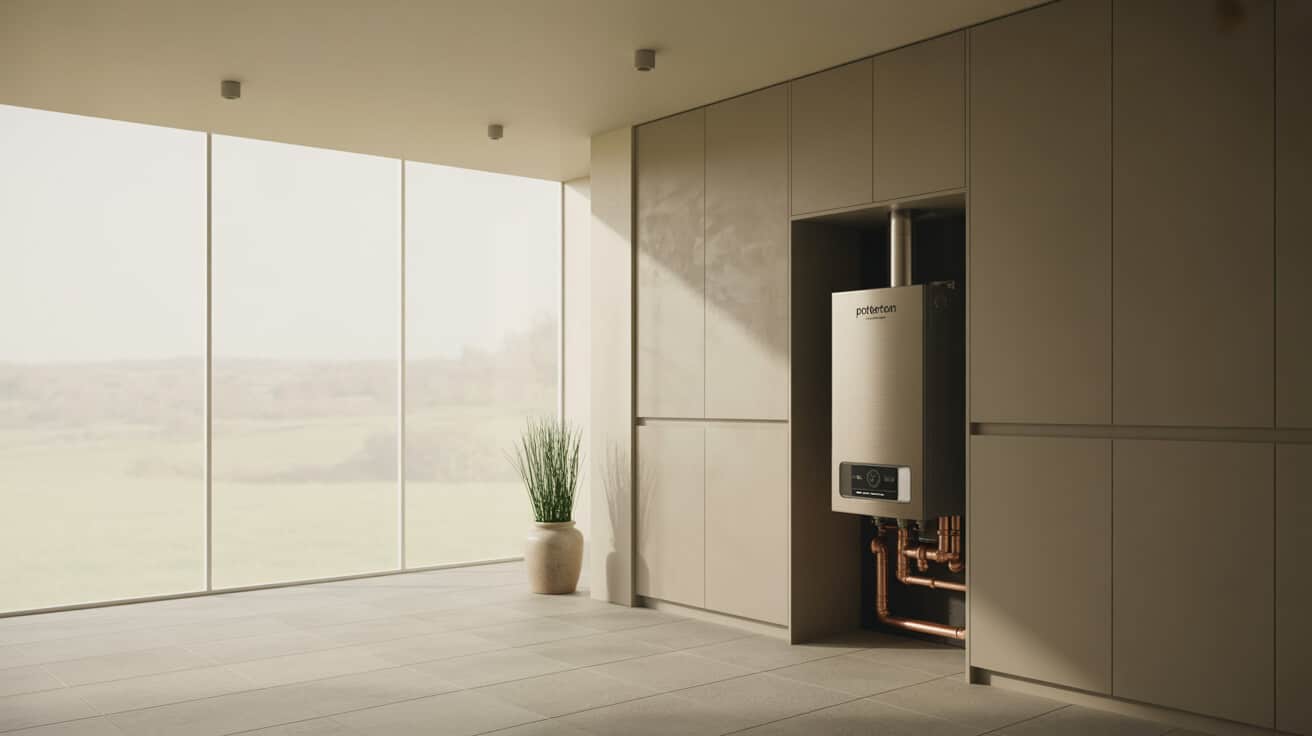Designed and manufactured under the well-established Potterton brand (a member of the Baxi Heating and BDR Thermea group), the Gold Combi has become a reference platform for high-efficiency replacement and compliance-focused installations. Standard models—spanning 24 kW, 28 kW, and 33 kW outputs—feature pre-mixed, modulating burners, modern digital interfaces, advanced system diagnostics, and support for popular wireless controls including OpenTherm. The combination of compact form, ease of servicing, and compatibility with diverse property stock has contributed to the appliance’s widespread adoption, with property managers, letting agents, and service providers such as Plumbers 4U frequently specifying this unit in upgrades, void property refits, and new construction projects.
Etymology or Name Origin
Potterton traces its origins to early twentieth-century British heating engineering, forging an enduring legacy within the United Kingdom’s domestic appliance manufacturing sector. The adoption of “Gold” as a brand modifier signified a class of reliable, high-performing products, targeting property managers and compliance-driven installers. The Baxi Heating integration and subsequent BDR Thermea Group consolidation combined Potterton’s engineering with large-scale manufacturing, service, and digital support capacity, expanding the Gold Combi family’s reach from individual homes to major housing portfolios.
Overview / Context
Combination boilers—often termed “combi” units—represent a dominant architecture in UK and European heating, offering both pressurised hot water and hydronic central heating from a single appliance. In contexts ranging from owner-occupied dwellings to agency-managed rental stock, the Gold Combi serves as a plug-and-play solution for fast refits, eliminating complications related to header tanks and external cylinders. Contemporary asset managers and developers gravitate toward the appliance for its compliance alignment, straightforward commissioning, and support from established engineering and maintenance services. With Plumbers 4U’s integration of digital scheduling and transparent record management, the Gold Combi platform extends your company’s operational agility and supports long-term property value protection.
History
Origins and Early Market
the adoption of combi boilers in the UK stemmed from urbanisation, space constraints, and the need to replace ageing, gravity-fed heating systems in mid-century housing stock. Potterton, recognised for pioneering heat-generation solutions since the early 1900s, expanded into combination appliances as property typologies evolved and energy-use scrutiny increased.
Milestones in Product Evolution
The 1980s and 1990s saw Potterton advance towards sealed, pressurised, instantly responsive appliances. With the market pivot towards higher efficiency, the Gold Combi series included aluminium and stainless-steel condensing heat exchangers, built-in expansion vessels, and digital user controls. System diagnostics were enhanced to minimise downtime for asset managers and servicing companies.
Technological and Regulatory Shifts
Adoption of condensing technology, modular burner logic, and ERP (Energy-related Products) directives shaped product development. Models were updated to accommodate stricter NOₓ emission standards, anticipatory digital controls, and compatibility with wireless and OpenTherm thermostats. These innovations aligned with UK Building Regulations, supporting agent compliance and insurance verification requirements for your organisation.
Recent Developments
Digital transformation in property management accentuated the need for interoperable, data-logging heating infrastructure. Potterton Gold Combi iterations responded with enhanced self-diagnostics, error code logging, smart home integration modules, and tool-free panel access—minimising both on-site disruption and resource allocation for your facilities management teams.

Concept / Description
A typical Potterton Gold Combi encompasses a sealed, microprocessor-optimised chassis, orchestrated to simultaneously provide hydronic heating and instantaneous hot water. Key components include:
- Condensing Heat Exchanger: Reclaims heat from exhaust gases, increasing fuel efficiency.
- Plate Heat Exchanger (DHW-specific): Facilitates rapid cold-to-hot water transition.
- Expansion Vessel: Absorbs pressure fluctuations, maintaining system stability.
- Circulating Pump: Drives heated water through your property’s radiators or underfloor circuits.
- Divertor Valve: Directs energy flow between heating and hot water circuits, responding to your demand.
- Microprocessor-Controlled PCB: Governs appliance operations, detects system faults, and provides user interface control.
- Low-NOₓ Modulating Burner: Adjusts flame intensity to heat demand, optimising fuel-to-heat conversion.
- Condensate Trap and Drain: Captures and neutralises acidic boiler byproducts.
- Service Valves and Gauge Panel: Allow rapid isolation, draining, filling, and pressure verification.
Externally, the appliance features a digital or dial-based interface, display screen, pressure gauge, and minimalistic outer casing coordinated to suit modern kitchen or utility environments. Flue options permit siting flexibility, whether for wall, ceiling, or internal-external termination, and side/front access panels streamline periodic servicing and component replacement.
Functionality / Purpose / Applications
Operating Principles
Combining a sealed heating circuit with a direct-fed mains water interface, the Gold Combi responds instantaneously when your thermostat or time-clock signals a need for heat, or your user opens a hot tap. When heating is called for, the modulating burner ignites, water circulates through radiators (or underfloor pipes), and heat output is regulated via feedback sensors. During hot water demand, a flow sensor triggers priority to the DHW plate exchanger, resulting in near-instantaneous heated delivery at pressure determined by the incoming mains supply.
Domestic and Commercial Use
- Owner-Occupied Homes: Supplies both central heating and high-flow-rate hot water efficiently.
- Portfolio and Social Housing: Favoured in large-scale upgrade programmes and refurbishment works due to compatibility with diverse property stock and asset compliance needs.
- Light Commercial/Small Office: Deployed in non-residential premises where demand aligns with household-level outputs.
Installation and Commissioning Environments
Installers select Gold Combi models for new-build, retrofit, and change-of-use projects where minimising installation time and maximising compliance tracking are imperative. Typical installation locations include kitchens, utilities, airing cupboards, or purpose-designed service risers. Flue positioning is optimised to local regulatory requirements and space constraints, a critical asset for multi-floor or high-density dwellings.
Classifications / Types / Variants
Model Range
| Model | Output (kW) | Hot Water Flow Rate (L/min @ 35°C rise) | Common Property Match |
|---|---|---|---|
| Gold Combi 24 | 24 | 9.8 | Flats, small houses |
| Gold Combi 28 | 28 | 11.4 | Medium houses, 1–2 baths |
| Gold Combi 33 | 33 | 13.5 | Larger houses, 2+ baths |
Each model is accompanied by a suite of accessory options—telescopic, vertical, or plume flue kits, system protection philtres, filling loops, and mechanical or digital timers. The appliance design accommodates wireless thermostat modules, OpenTherm integration kits, and advanced programmable controls to optimise your indoor comfort.
Accessory/Option Sets
- Flue adaptation kits: Flexibility for multiple instal locations.
- Magnetic debris philtres: Enhance system lifespan by reducing sediment build-up.
- OpenTherm/Smart modules: Future-proof temperature control and energy management for your organisation.
- Quick-fit mounting jigs: Reduce installation time, labour, and site disruption.
Systems / Tools / Methodologies
Installation Tools & Methods
- Gas-tightness testing metres: — ensure installation meets safety.
- Combustion gas analyzers: — verify burner performance and emission compliance.
- Isolation, filling, and draining valves: — enable efficient commissioning, maintenance, and emergency repairs.
- Digital PCB diagnostic: — deliver fault code and maintenance prompts during operation.
Servicing and Maintenance Methodologies
- Annual service protocols: Heat exchanger and burner cleaning, pressure vessel inspection, functional safety check of all controls and sensors.
- Inhibitor dosing: Prevents internal corrosion and sediment.
- System philtre cleaning: Optimises flow, reduces blockages, extends asset lifespan.
Owner/Tenant Practices
- Regular monitoring of system pressure, resetting as needed using user-facing fill valves.
- Immediate reporting of error codes or pressure loss to property managers—supported by services such as those offered by Plumbers 4U to ensure response efficacy for your organisation.

Stakeholders / Entities Involved
Property Owners and Asset Managers
Owners determine specification, oversee installation, service, and regulatory compliance on behalf of their business or personal portfolio. Asset managers use digital records and direct service contracts, often leveraging providers with verifiable compliance processes.
Installers and Service Professionals
Only Gas Safe registered engineers are authorised to instal and maintain the boiler, with some (including Plumbers 4U) offering “end-to-end” documentation, compliance, annual reminders, and emergency response for your asset safety and value.
Letting Agents and Housing Providers
Agents facilitate annual checks, repairs, and tenant communication, document all actions for legal compliance, and coordinate with service providers to minimise periods with loss of heating or hot water for your tenants.
Occupiers
Homeowners and tenants interact with the appliance via programmable timers, thermostats, and pressure dials, reset as instructed, and call for service upon detection of persistent faults or error codes.
Manufacturer and Support
Potterton, as part of Baxi Heating and BDR Thermea, issues technical bulletins, maintains digital product manuals, and supports warranty claims for your company through part networks and technical helplines.
Legal / Regulatory / Ethical Considerations
Regulatory Standards and Documentation
All installations legally require:
- Building Regulations: Part L (fuel/power use), Part G (domestic hot water safety).
- Gas Safe Register: Only registered engineers may carry out installation and repairs.
- Boiler Plus and ERP: Mandated minimum controls, labelling, and efficiency.
Property managers and agents must keep current:
- Benchmark logbook: (commissioning, servicing, repairs)
- Annual Gas Safety Certificates:
- Warranty registration and maintenance receipts:
Insurance Implications
Non-compliance with servicing intervals, failure to maintain current safety certification, or use of unauthorised installers can void property owner or asset insurance coverage. Your company benefits from contracting service providers who offer complete documentation and digital record systems.
Landlord and Asset Manager Responsibilities
Landlords are required by law to annually verify gas safety, maintain full records, and provide tenants with up-to-date certificates. Failure exposes your organisation to legal and financial penalties, exemplifying the importance of robust service protocols and transparent reporting.
Ethical Standards
Ethical operation entails transparent communication with occupiers, proactive scheduling of maintenance, full documentation access, and rapid resolution of service issues—reducing tenant complaints and regulatory intervention.
Performance Metrics / Data / Measurements
Efficiency, Emissions, and Reliability
- ERP Seasonal Efficiency: ≥90% (A-rated).
- NOₓ Class: 6 (best-in-class emissions in line with current UK standards).
- DHW Flow Rate: 9.8–13.5 L/min (model-dependent).
- System Design Lifespan: 10–15 years under planned servicing.
- Warranty Terms: Typically 2–7 years when registered with the manufacturer, maintained by compliant engineers.
| Metric | Value/Range | Standard |
|---|---|---|
| Seasonal Efficiency | ≥90% | ERP A / |
SEDBUK Band A | | NOₓ Class | 6 | ERP/Building Regs | | Hot Water Flow (28kW) | 11.4 L/min @ 35°C Δ | Manufacturer Data | | Pressure Operating | 1.0–1.5 bar | System Guidelines | | Maintenance Interval | Annual (minimum) | Gas Safe/Insurer Policy |
Maintenance and Longevity
Regular system philtre cleaning, corrosion inhibitor dosing, and periodic service checks directly correlate with reduced emergency callouts and maximised operational lifespan, supporting your company’s property asset performance and tenant satisfaction.
Challenges / Barriers / Limitations
Operational Issues
- Persistent fault codes (E133, E119): May indicate pressure loss, ignition failure, or component fatigue, and require qualified diagnostics.
- Water quality issues: Hard water may accelerate scale accumulation, especially where limescale reducers or philtres are not fitted.
- Space and Venting Limitations: older properties may lack compliant flue runs or sufficient wall space, requiring pre-intervention reviews.
Infrastructure and Asset Barriers
- Non-standard pipework, system sludge, or low incoming mains pressure may necessitate pre-instal plumbing upgrades.
- Complex property layouts may exceed single-combi output limitation—portfolio or facility managers should evaluate aggregate demand.
Financial and Market Constraints
Your organisation’s budget may constrain proactive replacement programmes or advanced smart controls. Balancing short-term capital expense with long-term savings or compliance risk reduction requires careful planning.
Maintenance and Lifecycle Barriers
Access issues (e.g., tenanted flats) can delay essential servicing for your asset schedule, increasing fault recurrence or compliance failure risk.
Impact / Influence / Legacy
Potterton Gold combi boilers have influenced UK property heating standardisation, particularly in housing association, landlord-managed, and multi-dwelling sectors. Their proven reliability and documentation features have supported asset managers’ movement towards digital service records, proactive certification, and on-demand repairs.
Trusted service providers, such as Plumbers 4U, have evolved service contracts and compliance systems directly around the strengths and patterns of installation, faulting, and recordkeeping that the Potterton Gold Combi family enables. These innovations solidify ongoing relevance for your long-term asset and compliance strategies.
Future directions, cultural relevance, and design discourse
The evolution of combination boiler technology is defined by efficiency, digital controls, and changing regulatory frameworks. Forthcoming models anticipate hydrogen-ready burners, ultra-low NOₓ, and deep integration with property management platforms. Regulatory bodies drive expectations for decarbonisation, prompting your company to evaluate renewable heat sources and enhanced smart controls for portfolio compliance.
Cultural shifts toward tenant comfort, energy transparency, and self-diagnosing infrastructure are exemplified by the Gold Combi’s integration into modern property management and housing culture. As your organisation adapts to the intersection of digital compliance, efficiency mandates, and new materials/science, the appliance’s role in both practice and perception remains significant—powerful enough to guide asset strategies, tenant experience, and operational visions well into the next era of UK housing.

